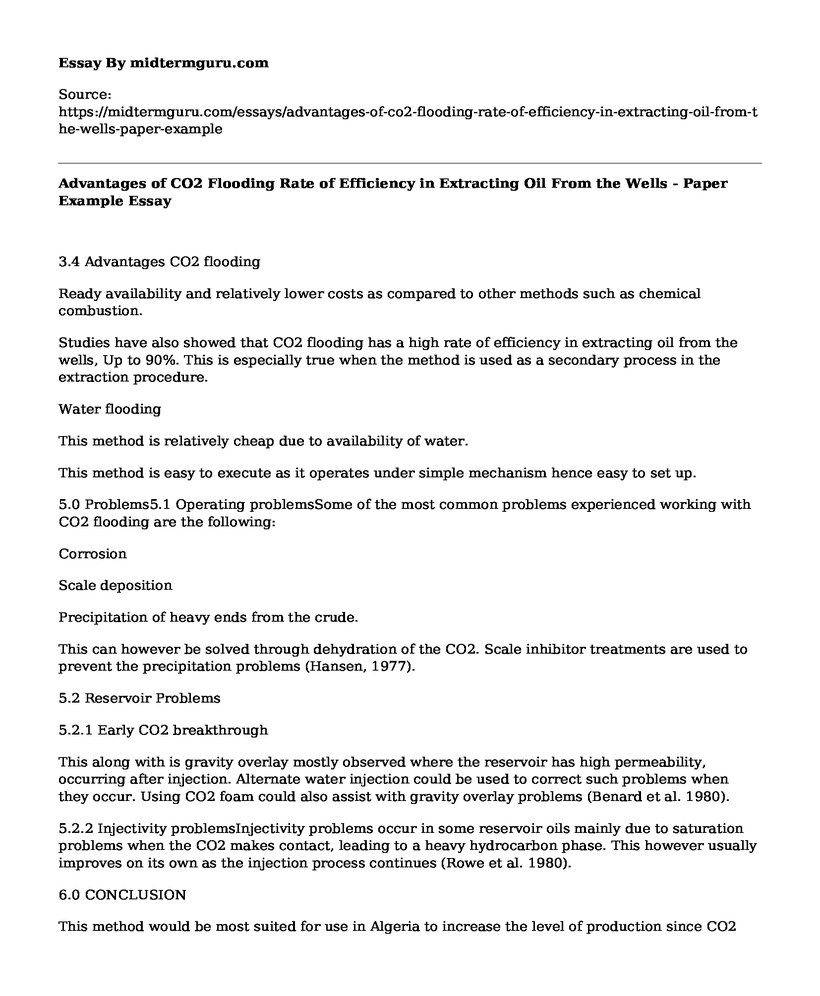3.4 Advantages CO2 flooding
Ready availability and relatively lower costs as compared to other methods such as chemical combustion.
Studies have also showed that CO2 flooding has a high rate of efficiency in extracting oil from the wells, Up to 90%. This is especially true when the method is used as a secondary process in the extraction procedure.
Water flooding
This method is relatively cheap due to availability of water.
This method is easy to execute as it operates under simple mechanism hence easy to set up.
5.0 Problems5.1 Operating problemsSome of the most common problems experienced working with CO2 flooding are the following:
Corrosion
Scale deposition
Precipitation of heavy ends from the crude.
This can however be solved through dehydration of the CO2. Scale inhibitor treatments are used to prevent the precipitation problems (Hansen, 1977).
5.2 Reservoir Problems
5.2.1 Early CO2 breakthrough
This along with is gravity overlay mostly observed where the reservoir has high permeability, occurring after injection. Alternate water injection could be used to correct such problems when they occur. Using CO2 foam could also assist with gravity overlay problems (Benard et al. 1980).
5.2.2 Injectivity problemsInjectivity problems occur in some reservoir oils mainly due to saturation problems when the CO2 makes contact, leading to a heavy hydrocarbon phase. This however usually improves on its own as the injection process continues (Rowe et al. 1980).
6.0 CONCLUSION
This method would be most suited for use in Algeria to increase the level of production since CO2 injection has been proven to be more effective in commercial oil production. This is especially due to its ability to recover residual oil left after water flooding.
CO2 flooding is applicable in both carbonate and sandstone reservoirs. At this stage of development though, its application to new formations will require both laboratory and field-testing to develop sufficient planning of the full-scale project.
On the downside however, a much higher degree of reservoir description is needed for a CO2 flood than for a water flood. A thief zone that would only cause trouble for a water flood may be disastrous for injection or more expensive CO2.
7.0 References
Benard., G.G, Holm, L.W and Harvey, C.P., 1980. Use of surfactant to reduce CO2 mobility in oil displacement. SOC. Pet. Eng.J., 20(8): 281-292
Eshkalak, M., Al Shalabi, E., & Aybar, U. (2014). Enhanced Gas Recovery by CO 2 Sequestration versus Re-fracturing Treatment in Unconventional Shale Gas Reservoirs. Research gate. Retrieved 8 April 2017, from https://www.researchgate.net/publication/285321017
Hansen, P.W., 1977. A CO2 tertiary recovery pilot, Little Creek Field, Missisipi. Soc. Pet. Eng. Annu. Denver., October 9-12, SPE 6747.
Holm, L.W. and Josendal, V.A., 1982. Effect of oil composition on miscible-type displacement by carbon dioxide. Soc. Pet. Eng., 22(2): 87-98
Rowe, H.G., York, S.D. and Ader, JC., 1981. Slaughter Estate Unit tertiary pilot performance. Soc. Pet. EOR Symp., Tulsa, Okla., April 5-8, SPE 9796.
Sebastian, H.M., Wenger, R.S and Renner, T.A., 1985. Correlation of minimum miscibility pressure for impure CO2 streams. J. Pet. Technol., 37(11): 2076-2082.
Cite this page
Advantages of CO2 Flooding Rate of Efficiency in Extracting Oil From the Wells - Paper Example. (2021, Jun 17). Retrieved from https://midtermguru.com/essays/advantages-of-co2-flooding-rate-of-efficiency-in-extracting-oil-from-the-wells-paper-example
If you are the original author of this essay and no longer wish to have it published on the midtermguru.com website, please click below to request its removal:
- Reserves in Petroleum
- Essay Sample on Golden Rice
- Argumentative Essay on Global Warming
- Animal Abuse in Hong Kong - Essay Sample
- Technology: Biggest Threat to Our Environment? - Essay Sample
- Driverless Cars: A Solution to Global Warming? - Essay Sample
- Animal Testing Should Be Banned - Argumentative Essay







